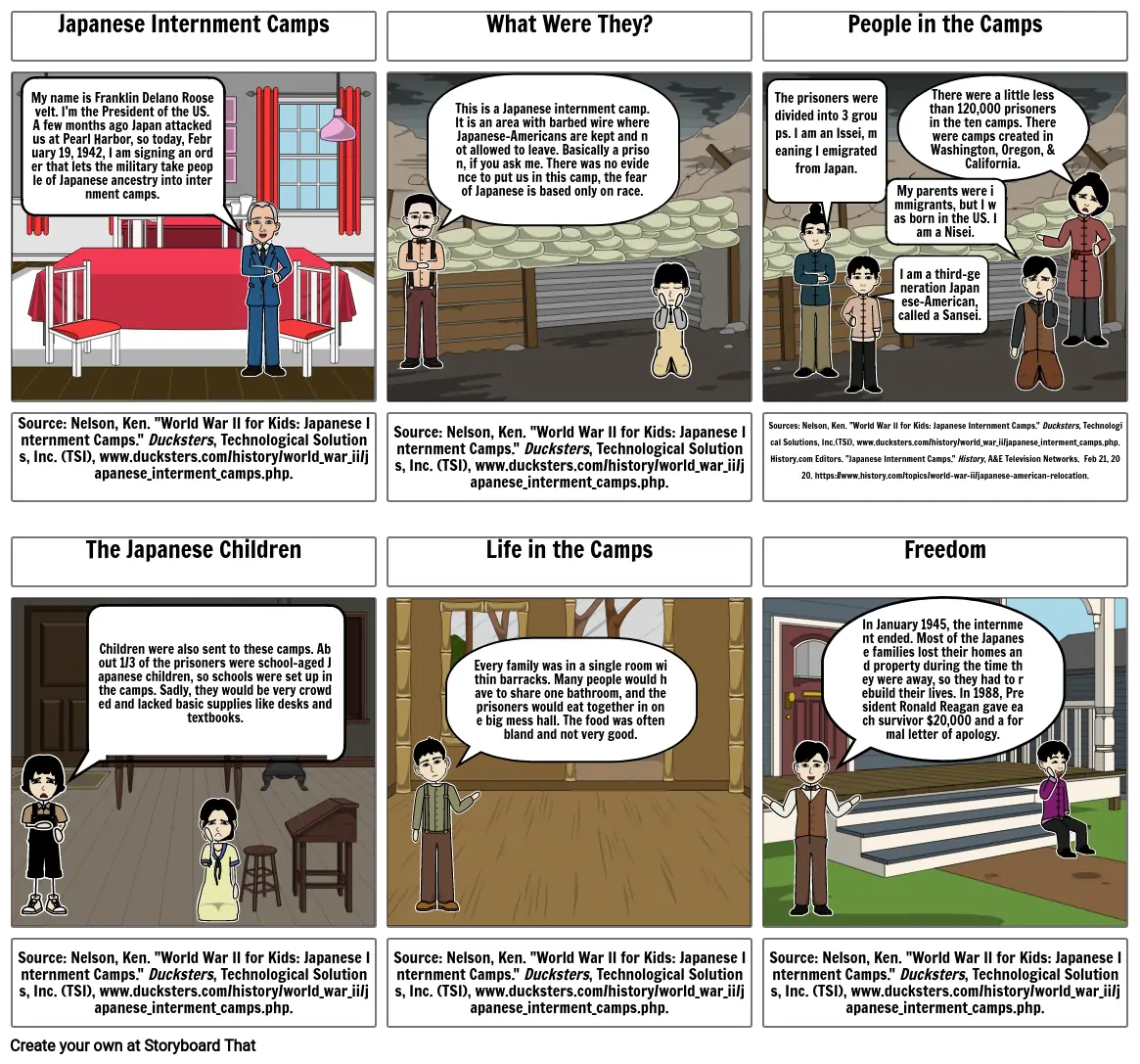Japanese Internment Camps

Texto do Storyboard
- Japanese Internment Camps
- My name is Franklin Delano Roosevelt. I'm the President of the US. A few months ago Japan attacked us at Pearl Harbor, so today, February 19, 1942, I am signing an order that lets the military take people of Japanese ancestry into internment camps.
- What Were They?
- This is a Japanese internment camp. It is an area with barbed wire where Japanese-Americans are kept and not allowed to leave. Basically a prison, if you ask me. There was no evidence to put us in this camp, the fear of Japanese is based only on race.
- People in the Camps
- The prisoners were divided into 3 groups. I am an Issei, meaning I emigrated from Japan.
- I am a third-generation Japanese-American, called a Sansei.
- My parents were immigrants, but I was born in the US. I am a Nisei.
- There were a little less than 120,000 prisoners in the ten camps. There were camps created in Washington, Oregon, & California.
- Source: Nelson, Ken. "World War II for Kids: Japanese Internment Camps." Ducksters, Technological Solutions, Inc. (TSI), www.ducksters.com/history/world_war_ii/japanese_interment_camps.php.
- The Japanese Children
- Children were also sent to these camps. About 1/3 of the prisoners were school-aged Japanese children, so schools were set up in the camps. Sadly, they would be very crowded and lacked basic supplies like desks and textbooks.
- Source: Nelson, Ken. "World War II for Kids: Japanese Internment Camps." Ducksters, Technological Solutions, Inc. (TSI), www.ducksters.com/history/world_war_ii/japanese_interment_camps.php.
- Life in the Camps
- Every family was in a single room within barracks. Many people would have to share one bathroom, and the prisoners would eat together in one big mess hall. The food was often bland and not very good.
- Sources: Nelson, Ken. "World War II for Kids: Japanese Internment Camps." Ducksters, Technological Solutions, Inc.(TSI), www.ducksters.com/history/world_war_ii/japanese_interment_camps.php.History.com Editors. "Japanese Internment Camps." History, A&E Television Networks. Feb 21, 2020. https://www.history.com/topics/world-war-ii/japanese-american-relocation.
- Freedom
- In January 1945, the internment ended. Most of the Japanese families lost their homes and property during the time they were away, so they had to rebuild their lives. In 1988, President Ronald Reagan gave each survivor $20,000 and a formal letter of apology.
- Source: Nelson, Ken. "World War II for Kids: Japanese Internment Camps." Ducksters, Technological Solutions, Inc. (TSI), www.ducksters.com/history/world_war_ii/japanese_interment_camps.php.
- Source: Nelson, Ken. "World War II for Kids: Japanese Internment Camps." Ducksters, Technological Solutions, Inc. (TSI), www.ducksters.com/history/world_war_ii/japanese_interment_camps.php.
- Source: Nelson, Ken. "World War II for Kids: Japanese Internment Camps." Ducksters, Technological Solutions, Inc. (TSI), www.ducksters.com/history/world_war_ii/japanese_interment_camps.php.
Mais de 30 milhões de storyboards criados

